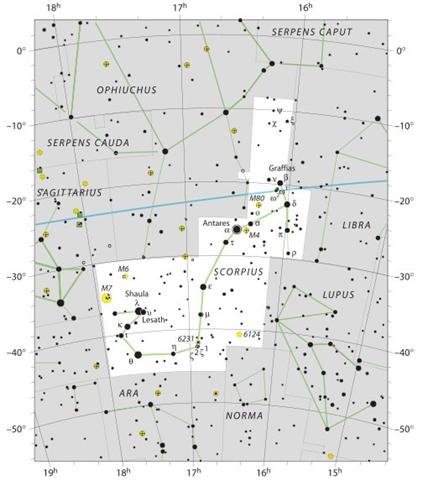1. The first named star to rise in Scorpius is not Acrab, for Dschubba (δ) - the forehead - is rising a day earlier:
Allen: "Graffias generally is said to be of unknown derivation; but since Γραψαĩος signifies 'Crab', it may be that here lies the origin of the title, for it is well known that the ideas and words for crab and scorpion were almost interchangeable in early days, from the belief that the latter creature was generated from the former.¹ ¹ This was held even by the learned Saint Augustine and Basil of the 4th century, and confidently expressed by Saint Isidore in his Origines et Etymologiae. It was thought by Grotius to be a 'Barbarian' designation for the Claws of the double constellation; and Bayer said the same, although he used the word for ξ Scorpii in the modern northern claw. In Burritt's Atlas of 1835 it appears for ξ of the northern Scale, the ancient northern Claw; but in the edition of 1856 he applied it to our β Scorpii, and in both editions he has a second β at the base of the tail, west of ε. The Century Dictionary prints it Grassias, probably from erroneously reading the early type for the letter f. β is near the junction of the left claw with the body, or in the arch of the Kite bow, 8º or 9º northwest of Antares. In some modern lists it is Acrab, - Riccioli´'s Aakrab schemali."
My astronomy book has Acrab for β and Grafias for ζ, which possibly is meant to be a π star in the G text:
22 / 7 is approximately equal to π. This is where the curved part of the tail is beginning.
When Sun has disappeared in the west there no longer is any order, only fumbling in the dark. My astronomy book has Lesath as ν, but in the star map above Lesath is υ. Lesath (ν) rose together with Sun in 'November 21:
As to the meaning of the name Lesath: "Upsilon Scorpii ... is a star located in the 'stinger' of the southern zodiac constellation of Scorpius, the scorpion. It has the traditional name Lesath (alternative spellings Leschath, Lesuth), from Arabic las'a = 'pass (or bite) of a poisonous animal'; but this is a miscorrection by Scaliger (a European astronomer who knew Arabic) for earlier 'Alascha', which came from Arabic al laţkha = 'the foggy patch', referring to the nearby open cluster M7. On the night sky it lies near the 1.6 magnitude star Lambda Scorpii, so the two form an optical pair that is sometimes called the Cat's Eyes." (Wikipedia) |




